Media | Articles
5 mistakes we made on a first-ever RV rental
What to do for spring break in a year when flights are difficult, hotels can be dicey, and your destination might decide to shut down before you get there? I thought I had a great substitute idea: our family would rent an RV and see the country the old-fashioned way.
The only problem: we couldn’t find one. Remember back when people were first hoarding toilet paper, followed by Clorox wipes, and we all thought, “I wish I could predict what will be the next hot item in demand.” I found the answer: people were buying RVs like crazy! Throughout the country dealers couldn’t keep up with demand. Apparently staying in hotels and interacting with other humans sounded terrifying to a lot of people because sales of new RVs jumped 57 percent during 2020 compared to 2019. Those who don’t want to purchase have turned to renting to the tune of a 2645 percent increase in bookings over the last 12 months. 88 percent of those are going to first-time renters.
All the commercial RV rental places near central Ohio were sold out or way overpriced, so we turned to the world of “Airbnb RVs”. There are a few options (outdoorsy.com, rvshare.com, jucyusa.com, escapecamervans.com, etc.) and we ended up at rvshare.com.
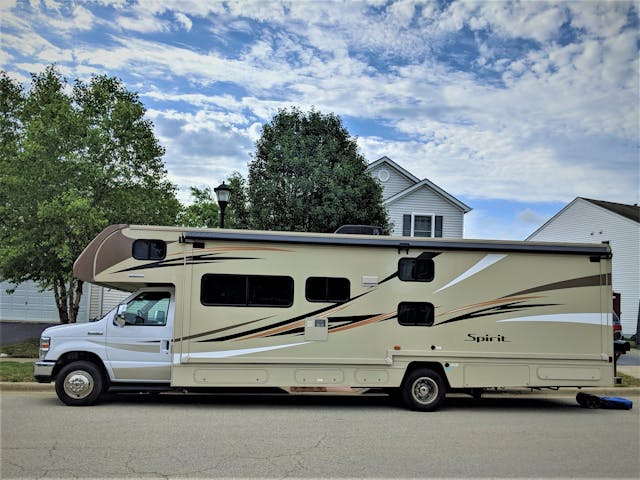
Every Columbus-based RV was booked for spring break, but we were able to source a class C Winnebago Spirit an hour and a half away in Dayton. With taxes/insurance/fees, we were out a little over $300/day. We booked immediately. Then I remembered I literally know nothing about RVing. Nor did we have anywhere to go. I briefly considered driving around our city’s outer belt for a few hours then parking in front of our house each night, but instead randomly booked a campsite by Mammoth Cave, Kentucky.
I have never driven any large vehicle—not even a U-Haul. In fact, my daily driver is a Honda Fit, and well, not a lot of the driving skills translate. I didn’t even know the difference between gray and black water and I only had two days to learn everything I needed. Our 33-foot-long behemoth featured the Ohio built Ford F450. To give you an idea of the differences I was facing, here is a little comparison.
Marketplace
Buy and sell classics with confidence
Honda Fit Winnebago Spirit
2,500lbs 14,500lbs
1.5-liter 4 cylinder 6.8-liter V10
117hp 305hp
106 ft-lbs torque 420 ft-lbs torque
5.5 ft wide 8.5 ft wide
5 ft height 11 ft height
10.6 gallon fuel tank 55 gallon fuel tank
33mpg highway TBD…
sleeps 0? Sleeps 10
The only category I can find that the Honda Fit wins is the number of cup holders accessible from the front seat. Surprisingly, the Fit has six to only two in the Winnebago (that’s just a lack of effort, Ford!).
For two days I watched YouTube videos on how to drive, park, level, and maintain an RV. This is the most important thing you can do if you are going to rent an RV for the first time. Don’t expect the owner to show you anything. I learned a lot from two YouTube channels: ‘Endless RVing’, and ‘Keep Your DayDream’. Because of some odd circumstances, I picked up our RV from the owner at 11 pm. He and his family were great, and we spent about an hour signing paperwork and learning where he stored everything in the RV and the locations of basic hookups. Literally nothing about how to drive it, though. I was handed the keys after midnight on a very tight neighborhood street an hour and a half from home. That first drive was scary.

Instead of rehashing what you can learn from actual experts, I’ll share five mistakes I made my first time RVing:
Mistake #1: Not locking all the doors
The owner of our coach told us that the side door had recently flung wide open while on the highway, so he recommended always using the deadbolt. Picturing my four kids riding in a RV at 70mph with the door wide open was enough to burn that advice into memory. My family was so excited in the morning after I (somehow) safety drove the beast home and wanted to get on the road right away. I knew I had to pause for a moment and be extra diligent to check that all doors and storage compartments both inside and out were closed and locked. Driving away from our house onto U.S. 23 only 30 seconds into our trip, I came to a red light that forced me to slam on the brakes. As the refrigerator vomited all our food onto the floor, I realized I may or may not have forgot to check that door. Unless you like your fresh blueberries rolling all over a used RV’s carpet, don’t be like me. Latch the fridge.

Mistake #2: Thinking I knew which side the gas cap was on
This may sound simple. One could assume you just look at your gas gauge on the instrument cluster like every other car and the little arrow will tell you. You’d be wrong.
One of the many reasons I wanted to rent the RV was the benefit of having a bathroom on board. I have four kids so don’t often get more than an hour or two of driving in without stopping. This time, I just dehydrated myself a little and took off. I kid you not, we were driving past Ohio State University 10 minutes from my house when my daughter first had to use the restroom. Four hours later the toilet had been used nine times before I stopped for lunch.
My wife had looked ahead, finding Flying J and Love’s gas stations along our route to choose from. I felt so prepared pulling into a truck stop next to those big rigs. I was confident no one was going to be able to tell this was my first time driving an RV. After carefully selecting the perfect pump to use in this very busy travel plaza, I had my wife jump out to make sure I was all lined up with the gas cap. When she couldn’t do this, (and after I accused her of not knowing what a gas cap is), we learned that Winnebago had moved the gas filler to the other side. Not cool. Maneuvering a 33-foot RV around a crowded gas station can be tough. If you don’t want truckers making fun of you on their CBs (like they did to me), know which side your gas cap is on.
Mistake #3: Forgetting to use an RV-specific GPS
RV navigation apps differ from goggle maps by providing more info about which lane to be in, elevation changes, the curviness of the road, and even upcoming weather. Some apps, like Roadtrippers and InRoute Route Planner, even help you find quirky attractions, while others like CoPilot RV provide route advice based on your vehicle size. Here is the important part to remember: you must actually use the aforementioned apps for them to, you know, work.
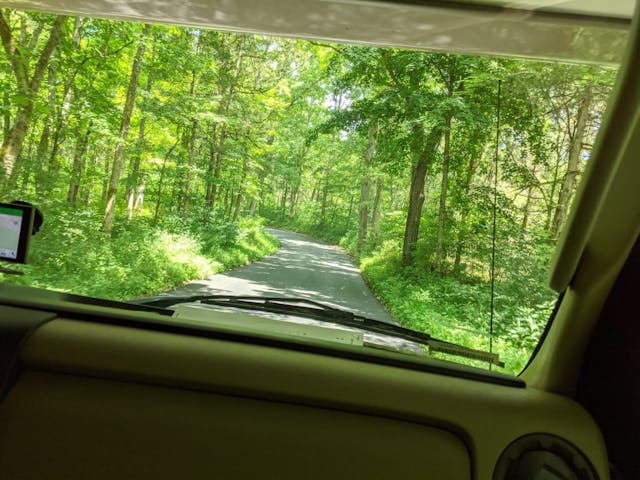
Within seconds of pulling out of Mammoth Cave I realized I had made a big mistake. Mostly because my wife kept telling me so, very loudly. Out of habit I had just grabbed my phone and asked Google to direct me home and hit the road. That meant taking the first left turn out of the park. When given the choice between Ridge Road and Mammoth Cave Pkwy and you are driving an RV … choose the way you came in on the nice Mammoth Cave Parkway!! Instead, I listened to the nice Goggle lady who told me to take a hard left on Ridge Road. (The name alone should have been a red flag.) I could see now why my wife was upset because the tiny barely paved “road” ahead of us was 7.8 miles of switchbacks, steep unprotected drop-offs, and barely enough room for one car. There was lit-tra-ly no turning back.
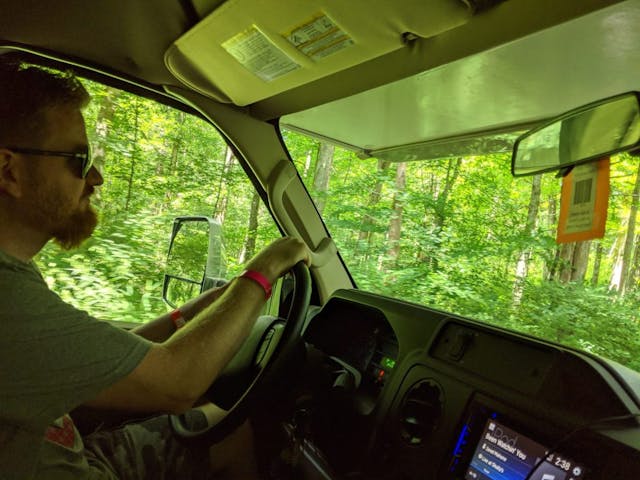
I prayed a lot over the next eight miles. For my brakes to not overheat, that I had got enough insurance coverage, that when we inevitably did fall off the road that we would get caught up in a tree and not slide all the way to the bottom of the gorge beside us, and please please let no other cars come our way. The first mile took me almost 10 minutes and a pound of sweat from my palms to navigate. The first tiny clearing revealed a Chevy Silverado coming at us. And, oh are you freakin’ kidding me … it was a dualie! Dropping down to 2 mph and placing my passenger side tires nervously tittering on the edge of a drop off, the trucks mirror came within 2 inches of mine as we passed. 32 minutes later, we made it out, exactly 2 miles farther down the highway than we would have been if we had taken the nice normal route. Don’t forget to use an RV navigation app so you don’t end up on one of *America’s 10 Most Scary Roads to Drive. (*I may or may not have just made that up.)
My wrong turn wasn’t half as bad as the couple’s that rented the Winnebago right before us though. They had taken it through the New England states and somewhere on a busy 55 mph two-lane road in Massachusetts they came across a bridge out of the blue that was 10’6” high. The Winnebago is 11’. After barely getting the beast stopped in time, they saw the growing line of traffic stacking up behind them with nowhere to go. It took the police coming out to direct hundreds of cars to back up and over 3 hours before they had enough room to reverse the RV out of there. Clearly, they weren’t using a GPS that took into account their vehicle height.
Mistake #4: Not checking, before leaving, that all features worked
Boy was I thankful our RV had a backup camera when I needed to find another gas pump available on the appropriate side of the vehicle. That is, until I realized the roof-mounted camera had been bumped and was facing the clouds. Another nice feature of our RV was a side camera system that showed the lane next to you when the turn signal was on. Unfortunately, I couldn’t see the screen. Like, at all. My polarized sunglasses made it completely invisible. Every time I needed to change lanes, for 1200 miles of driving, I had to take my sunglasses off first. Not ideal (nor safe). I should have sucked it up and wore my wife’s glasses or bought $1 pair from a gas station instead of acting like it was no big deal for multiple days of driving.
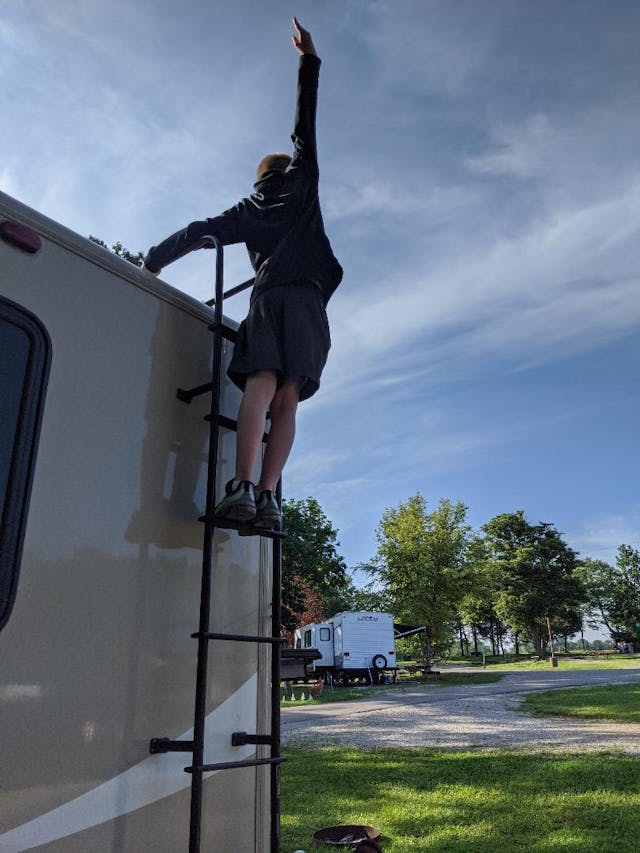
Mistake #5: Not practicing in a parking lot before departure
One thing I didn’t learn from YouTube was what a rear overhang was. The best way for me to understand this would have been to go to a parking lot to see what it is like to have everything behind the rear axle go in the opposite direction of where I was turning. Bottom line, I was lucky I didn’t hit something before I understood this principle. If you don’t want to rely on stupid luck (like me) to not have your back-end swing into the lane next to you on a turn and hit something, then go to a parking lot and watch the painted lines as you turn to know how much overhang you have before you take to the streets.
Something else I wasn’t prepared for was the fact that when a semi passes you in an RV, the wind literally will shove you out of your lane if you’re not prepared. I learned this on interstate 70 at 12:45 AM, my first night driving when I found myself struggling to keep the RV from sliding into a ditch after a semi passed me for the first time. The air coming off a heavier 18-wheeler will push the lighter Winnebago to the side by a good 5 feet if you aren’t expecting it. Driving a “relatively” lightweight RV means slightly steering INTO the side of the passing semitruck to avoid being pushed.
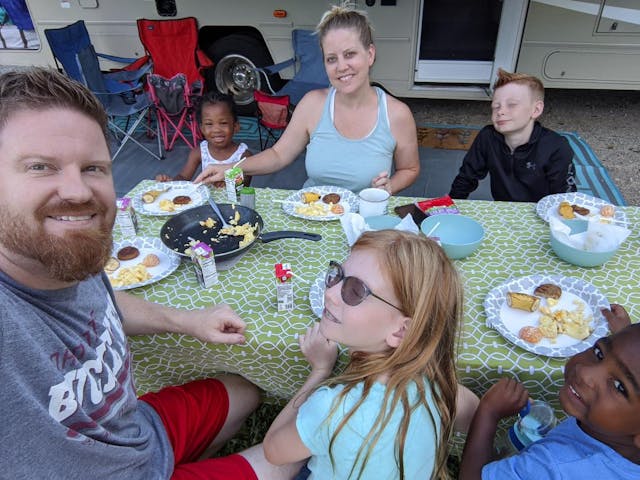
Lessons were learned, and I loved RVing and hope to do again someday. We stayed at a Jellystone campground at Mammoth Caves, which I would highly recommend. If you research traveling by RV you will often read that “RVing is a great way save money on your vacation,” but those articles are all written by dirty liars. RVing is great fun, but you DO. NOT. SAVE. MONEY. After 1200 miles I averaged a whopping 8.9 mpg. Still, if you’re looking for something to do, why not try driving something you’ve never driven before like I did to make a lifetime of memories in one short trip. With a lot of schools offering distance learning and workplaces operating fully online, the RV could be your bus, hotel, restaurant, school, and even office all wrapped into one. My advice is to just go slow, don’t try to get somewhere at a specific time. Everything just takes longer in a RV. Oh, and make sure your blueberries are secure.















